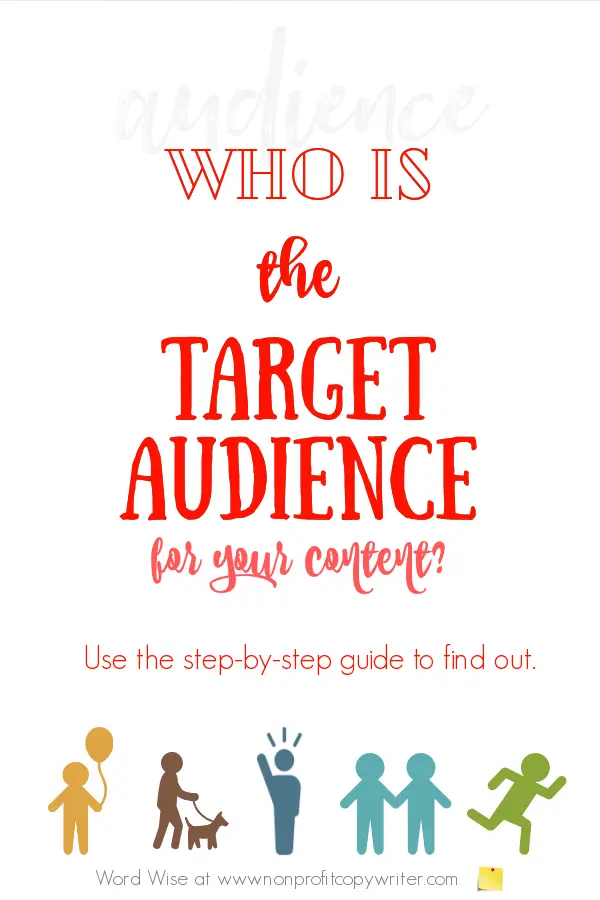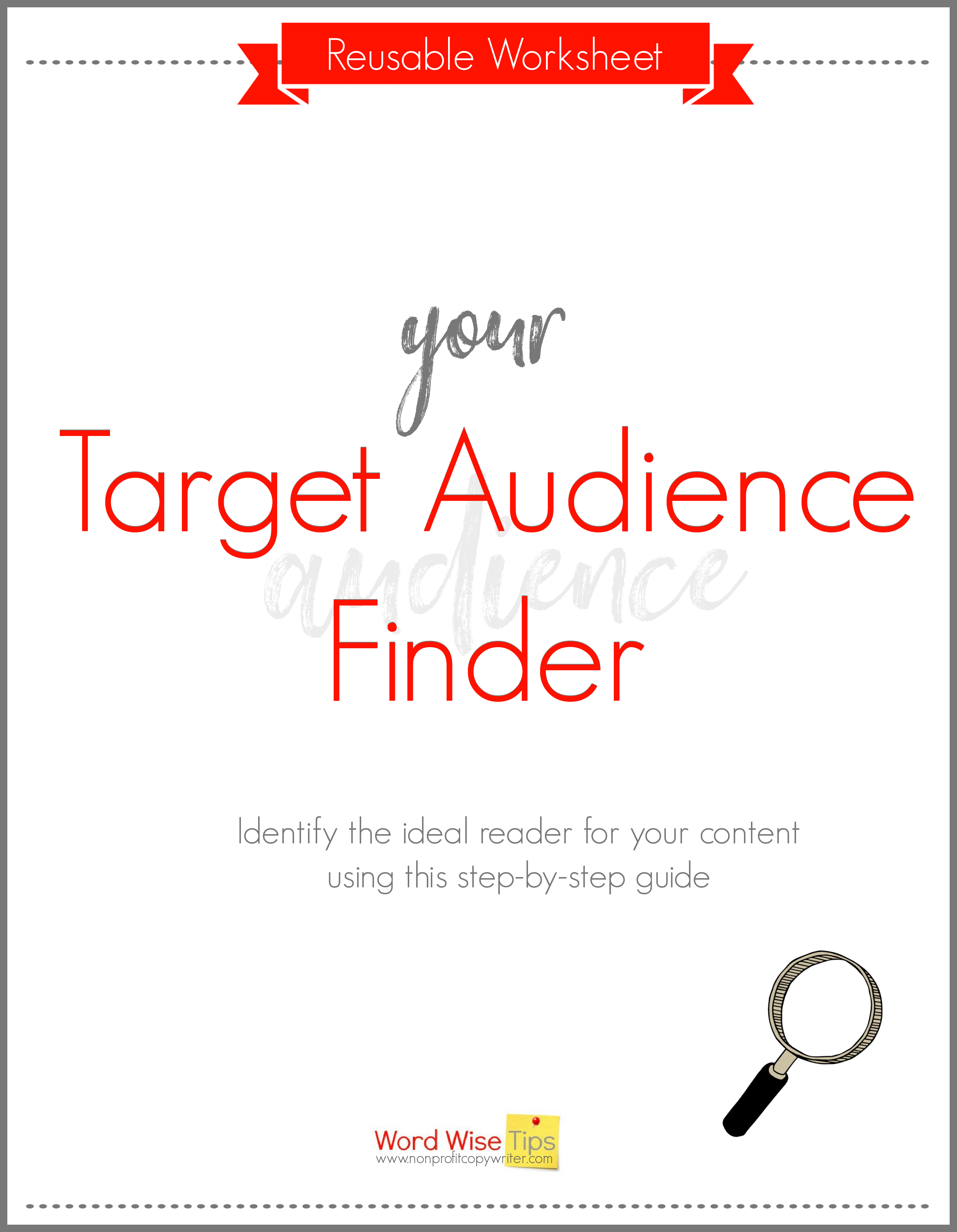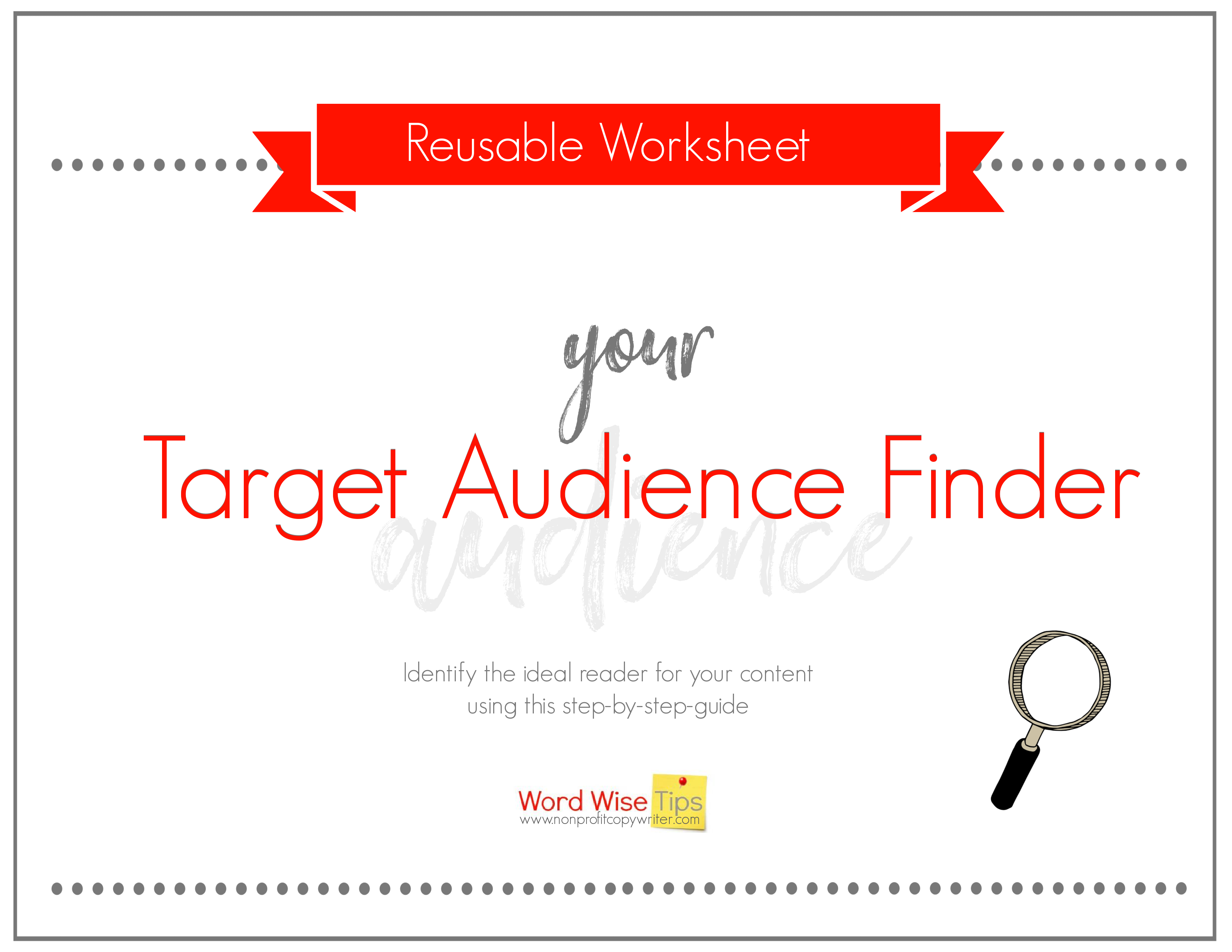Save Time: Get 5 Simple Writing Tips
you can put to use in 10 minutes
Who Is the Target Audience for Your Content?
Award-winning writer Kathy Widenhouse has helped hundreds of nonprofits and writers produce successful content , with 750K+ views for her writing tutorials. She is the author of 9 books. See more of Kathy’s content here.
Updated 9.16.25
Who is the target audience for your blog … your book … your article … your website … your current writing project?
You must answer that question before you start to write. It’s not enough to have a vague idea of your content consumers. Rather, you need a detailed description.
What happens when you identify your target audience
When you’ve identified your ideal target persona, you write to that reader’s needs and wants. You answer her specific questions and help solve the problems she has. And here’s what happens then …
Rebecca Reader readers a first piece of your content. She notices that you address the issue she faces and even better, you provide answers. She feels like you “get” her.
Very quickly, Rebecca Reader becomes your fan. She looks forward to each new bit of content you create. She shares your posts and recommends your books and flags your articles. Or if she’s a client, she hires you again
What happens when you don’t identify your target audience
But when you don’t clearly identify who is the target audience for your content, you have a completely different scenario. You try to write to everybody. At first glance, that’s a savvy strategy. Include as many people as possible and you’ll pull in more readers, right?
Wrong. Rebecca Reader already grapples with information overload. Throw a bunch of generalized information in Rebecca Reader’s way and you give her an excuse to skip your blog post or your email or your book or content altogether. Too many outlets and options scream for her attention. Rebecca needs specific information and if you can’t deliver it, she will find it elsewhere.
But address a hot-button issue that’s been on Rebecca Reader’s mind? Oh, yeah. She’ll bite and click and read. And come back for more.
Identifying your target audience – or not – determines your success in building a readership and a platform.
How can you make sure to engage Rebecca Reader? First …
What is a target audience?
Your target audience is a group of people most likely to be interested in your content. You may hear them referred to as your target market, core audience, target demographic, intended readers, target persona, primary audience, ideal customer avatar…
If it seems like an overwhelming task to identify your intended reader, never fear. This guide will help. (You can even download your own fillable, reusable copy here.)
How to identify your target audience
Ask these 3 questions to identify your target audience.
1. Who?
Who do you want to help with your blog, your book, or other piece of content? Identify your audience by recording characteristics that differentiate them from others. Are you writing to quilters … real estate investors … college students trying to get into law school? Be specific.
Let’s say you are writing to quilters. Drill down further. Are they legacy quilters – those who learned at Grandma’s knee? Professional quilters? New or wannabe quilters?
Write a composite description of your ideal reader. To find answers, research current industry trends, the demand for books, courses, and content that swirl around your topic, and comments on social media groups in your niche. Answer these questions:
- What is your reader’s median age?
- What is your average reader’s gender?
- What is your average reader’s marital status?
- Does your average reader have children?
- What is your average reader’s education?
- How is your average reader employed?
- What are your reader's beliefs, world view, core values?
- What is your average reader’s annual income?
- Does your average reader own his own home?
- What are your reader’s special interests?
(You can download the list and worksheet to use for yourself.)
Now that you know a bit more about your intended reader …
2. What?
What does this reader need help with? What problem can you solve … what cause can you address … what answers does she need? And on the other side of the coin, what doesn’t she need or want? Here’s where you define the purpose of your content, but you do so from the reader’s point of view.
That means you need to poke around to get some facts. And you need to do a bit of keyword research to see what they’re looking for.
Back to our example. You decide to target quilting wannabes and newcomers. After you do a bit of digging, you learn number of people completing a craft project in the last 12 months has increased steadily, now totaling 85+ million in North America (thank you, Pinterest.) Most of these crafters pursue their hobby in order to decorate their home, make gifts, or enjoy a creative outlet.
But you learn that just 30 million of these crafters know how to sew. That gives you some important information about what this target demographic doesn’t need and what they do need.
- They don’t need tips on using a hot glue gun or 7 fonts to use on wooden signs.
- They don’t lack adventuresome spirits. They spend $35 billion a year on craft paint, ribbons, dried flowers, kits, fabrics, and classes to satisfy their creative urges.
- They do need and want basic sewing skills. You a list of SEO terms associated with learn to sew and beginning quilter with high search and low results data. If only someone would explain to them in plain terms how to thread a bobbin machine or wield a rotary cutter!
- They also need confidence. They want to know that quilting is possible for them.
Process all this informational goodness and summarize. A helpful tip: use an action verb to describe the help you offer. Your content helps your reader do something.
How can you help them scratch that itch? Give them practical tips on choosing a sewing machine or layering batting with a quilt top and back. Provide online classes, step-by-step guides, tools, and encouragement for crafters so they can acquire basic sewing and quilting skills.
The answer to the question, “What do they need?” is “They need and want to acquire basic sewing and quilting skills.”
3. Why?
Why should this audience read your content? It’s not quite enough to target who needs help and what help you’ll give them. They need to see a benefit in your headline or blog post or content so they know they’re in the right place (and not wasting their time.)
If you struggle to give an answer to “Why should they read what I write?” then ask this: what results will your reader get? What will be different for her? What outcomes can she expect? What questions about sewing and quilting does she ask on forums and in online groups?
Back to our example. Crafters spend an average of six hours a week on their hobby. It offers entertainment and relaxation, yes. But once they put away yarn and buttons and needles, these creatives have a finished project to show for their time and effort.
Your content answers “Why should they read this?” when it focuses on the satisfaction they’ll have in producing a baby quilt or wall hanging or piecework home décor that become family heirlooms. If you offer headlines like 3 Easy Quilting Patterns Anyone Can Master and 2 Simple Quilting Projects Beginners Can Complete in a Day, your target audience will see the benefit of reading your content.
Put it together: who is the target audience for your content?
Put together the answers to these 3 questions with this simple template -- and you can uncover who is the target audience for your content.
- My content will help [Who: identify a specific group of people]
- To [What: state an action]
- So that [Why: the result]
Going back to our example ...
- My content will help [crafters/wannabe quilters]
- To [learn quilting basics]
- So [they can complete quilting projects].
Who is the target audience for your content?
As you study the demographics of your target readers, you learn that most new quilters are females in their 50s. They have children. Many have retired or are getting close to doing so. They’ve always loved quilts. Some of them even learned to sew when they were 12 years old but need a refresher. Now that these crafters have more time and money, they want to try their hand at quilting.
Hm. That description sounds a lot like your husband’s Aunt Lydia. How handy! The best way to write authentically to your target reader is to choose someone you know who fits your profile.
And since you’ve already gathered lots of Lydia’s questions, you’ve got plenty of ideas for content. Imagine you’re having a conversation with that person over a cup of coffee – in this case, Aunt Lydia.
Now, you’re ready to write to your target reader.
More Writing Tips for New Writers
My Sanity-Saving Research Tip for Writers ...
The Best Writing Habit for New Writers ...
Don’t Be A Writer For Everyone. Choose Your Niche Audience...
Want More Readers? Use the Know Like Trust Principle ...
Want More Traffic? Cross-Posting Is Easy ...
Your Writing: Is It “Good Enough”?
Two Types of Readers That Pay You To Write ...
Identify your ideal reader with this Target Audience Finder worksheet ...
Know Your Audience Before You Write ...
Your Target Audience: Here’s How to ID Them ...
Identify Your Audience With These 3 Questions ...
More content writing tips on our Pinterest board ...
Return from Who Is the Target Audience for Your Content?
to Nonprofit Copywriter home
As an Amazon Associate I earn from qualifying purchases.
Share This Page

Named to 2022 Writer's Digest list
BEST GENRE/NICHE WRITING WEBSITE


Stop Wasting Time!
Grab your exclusive FREE guide, "5 Simple Writing Tips You Can Put to Use in 10 Minutes or Less"














